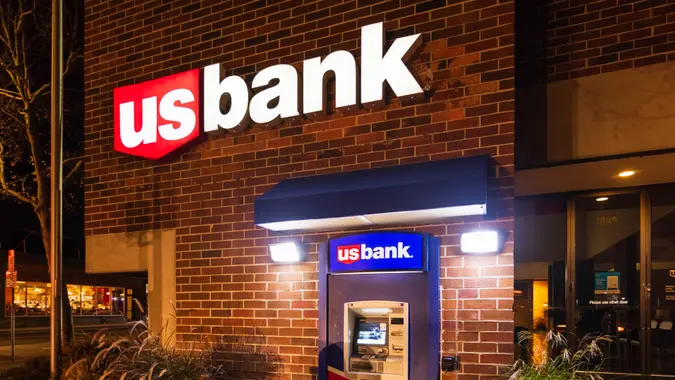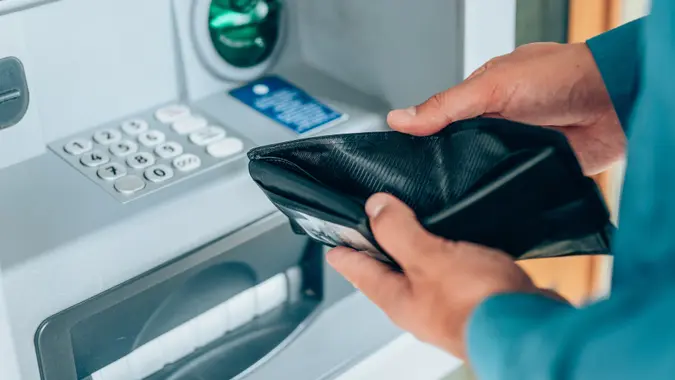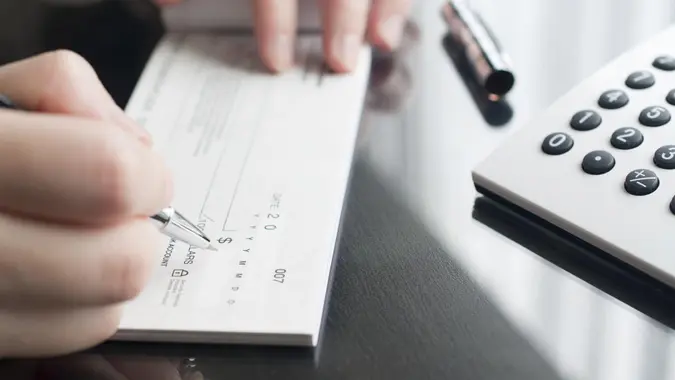How To Close a Bank Account: A Step-by-Step Guide

Commitment to Our Readers
GOBankingRates' editorial team is committed to bringing you unbiased reviews and information. We use data-driven methodologies to evaluate financial products and services - our reviews and ratings are not influenced by advertisers. You can read more about our editorial guidelines and our products and services review methodology.

20 Years
Helping You Live Richer

Reviewed
by Experts

Trusted by
Millions of Readers
Closing a bank account might seem like a hassle, but with the right steps, it can be a smooth and stress-free process. Whether you’re switching to a new bank, cutting down on accounts or avoiding high fees, knowing how to close a bank account properly ensures you don’t run into any surprises. If you’re ready to switch banks, find out how to close a bank account.
Signs It’s Time to Close Your Bank Account
There are several reasons you may want close down a bank account, including:
- High fees: If your bank charges excessive fees for maintenance, overdrafts or ATM use, switching to a fee-free account can save money.
- Poor customer service: If you frequently deal with unhelpful customer support or inconvenient banking policies, it might be time to move on.
- Better banking options: Online banks and credit unions often offer higher interest rates, better benefits and lower fees.
- Too many accounts: Simplifying finances by consolidating accounts makes managing money easier.
How Do You Close a Bank Account?
Closing down your bank account can be a time-consuming and confusing task, especially if you’ve only used a few accounts. Here’s a step-by-step walkthrough for closing down that old bank account.
1. Open a New Account (If Necessary)
Before closing your current account, make sure you have another one set up. Having a new account ready helps you avoid payment disruptions and transition seamlessly.
- Research and compare different banks or credit unions for lower fees and better perks.
- Set up your new account and ensure it’s active before transferring any money.
- Order a debit card and checks (if applicable) so you have access to your funds immediately.
2. Transfer or Withdraw Your Funds
Ensure all money in your account is safely transferred or withdrawn to prevent any loss of funds.
- Transfer your balance to your new account via online banking, wire transfer or cashier’s check.
- Withdraw cash if necessary, keeping within ATM limits.
- Leave a small balance until all pending transactions have cleared.
Tip: Some banks charge a minimum balance fee, so check their policy before transferring funds.
3. Cancel Direct Deposits and Automatic Payments
To avoid payment disruptions, update your direct deposits, subscriptions and automatic bill payments linked to the old account.
- Switch payroll deposits to your new account (contact your employer’s HR department).
- Update automatic bill payments (utilities, mortgage, subscriptions like Netflix and Spotify).
- Check for scheduled payments to avoid overdrafts or returned payments.
Pro Tip: Keep your old account open for one full billing cycle to ensure no payments are missed.
4. Obtain and Fill Out Account Closure Forms
Most banks require an account closure request to officially process your request.
- Visit a branch or check online for closure forms. Some banks allow account closures via secure messaging or phone requests.
- Provide identification and confirm your details with the bank.
- Request a written confirmation stating the account has been closed.
If closing the account in person, ask about any final interest earnings or pending fees to avoid surprises.
5. Confirm Account Closure
Even after submitting the request, make sure the account is fully closed.
- Check for any remaining balance that may have been left due to interest earnings or fees.
- Monitor your old account for a few weeks to ensure no unauthorized charges appear.
- Destroy old checks and debit cards linked to the account to prevent fraud.
Final Check: If your bank account is still accessible online, follow up with customer service to verify closure.
Things To Consider Before Closing Your Account
Before making the final decision, be aware of these potential issues:
- Early closure fees: Some banks charge fees if you close an account within 60 to 90 days of opening.
- Overdraft protection: If your account is linked to a credit line or savings account, disconnect them before closure.
- Account records: Keep copies of past statements and closure confirmation for future reference.
Tip
If you’ve had your account for a long time, keeping a final statement may be helpful for credit history verification.
What to Do After You Close a Bank Account
Closing a bank account doesn’t mean you’re done just yet. Taking a few final steps can help you avoid fees, identity theft, or payment disruptions. Here’s what to do after closing a bank account:
- Destroy old checks and debit cards. Shred or cut up any unused checks and debit cards tied to the closed account to prevent fraud or confusion.
- Monitor for residual transactions. Keep an eye out for any automatic payments, refunds, or deposits that may still be linked to your old account. If anything is missed, contact the sender to update your information.
- Update your payment and deposit info. Make sure you’ve updated all linked services–like your employer’s payroll system, streaming subscriptions, and utility bills–with your new bank account details.
- Save your account statements. Download and store past bank statements before closure, especially if you need them for taxes, loans, or financial records.
- Confirm final closure. Follow up with your bank to ensure the account is officially closed and that there’s no lingering balance, especially if you requested closure by mail or online.
Taking these steps can give you peace of mind and help you make a clean transition to your new bank account.
Alternative Options to Consider
If you’re considering closing your bank account but are unsure, explore these alternatives:
- Renegotiating terms: Some banks may waive fees or offer better terms if you express dissatisfaction.
- Switching account types: Downgrading to a no-fee checking or savings account can be a better solution.
- Keeping the account open with a minimal balance: This can be useful if you need a secondary account for future use.
Is It Time to Close Your Bank Account?
Closing a bank account is a straightforward process, but it requires careful planning to avoid unnecessary fees and disruptions. Whether you’re switching to a new bank or simplifying your finances, following these steps will ensure a hassle-free transition.
Ready to take the next steps towards canceling your bank account? If you’re ready to switch, compare new banking options to find one that offers better benefits and fewer fees.
How To Close a Bank Account FAQ
Here are answers to your frequently asked questions about closing a bank account.- Can I close a bank account online?
- Some banks allow you to close your account online. Check by logging into your bank and looking for an account closure option. If you don't see it, try contacting customer service or visiting the bank.
- Is there a fee for closing a bank account?
- Generally, banks don't charge for closing an account. Some banks may charge if you close your account within 90 to 180 days of opening.
- How do I permanently close my bank account?
- To permanently close your account, you'll need:
- Zero the balance.
- Cancel recurring payments.
- Contact your bank and request that the account be closed.
- Receive written confirmation that the account is closed.
- Monitor the account to make certain there are no surprise charges.
- To permanently close your account, you'll need:
- What documents and information are needed to close a bank account?
- You need your account number, a government ID such as a state-issued driver's license or a U.S. passport, a close request form and a zero balance in your account.
Joe Evans, Daria Uhlig, Katy Hebebrand and Virginia Anderson contributed to the reporting for this article.
Editorial Note: This content is not provided by any entity covered in this article. Any opinions, analyses, reviews, ratings or recommendations expressed in this article are those of the author alone and have not been reviewed, approved or otherwise endorsed by any entity named in this article.
Our in-house research team and on-site financial experts work together to create content that’s accurate, impartial, and up to date. We fact-check every single statistic, quote and fact using trusted primary resources to make sure the information we provide is correct. You can learn more about GOBankingRates’ processes and standards in our editorial policy.
- Federal Deposit Insurance Corporation "Overdraft and Account Fees"
- Bureau of the Fiscal Service "Direct Deposit (Electronic Funds Transfer)"
- Federal Deposit Insurance Corporation "Online Delivery of Banking Services: Making Consumers Feel Secure"
- Consumer Financial Protection Bureau "What is a wire transfer?"
 Written by
Written by  Edited by
Edited by 
























